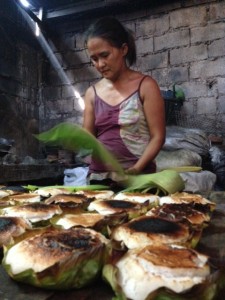
Social Welfare and Development Secretary Dinky Soliman said that on a positive note, every disaster is an opportunity for a victim to prove his resiliency, start life anew and in fact, have a better life.
Secretary Soliman cited how Geraldine Alavanza, 39, of Cagayan de Oro City rose from the wrath of typhoon Sendong which hit the city on December 17, 2011.
Geraldine now has revived her bibingka business and made it even better and bigger through the DSWD’s Convergence Strategy.
Secretary Soliman assured disaster victims that they have a government they can rely on to bounce back.
Unique story to tell
“It was the second day of Misa de Gallo. At the peak of the storm, I was preparing bibingka in the family’s makeshift pugon to sell to churchgoers after the midnight mass. When I looked back, the water was already knee deep inside our house,” Geraldine recalled.
Geraldine quickly ran to her parents and children who were sleeping in the family’s shared bedroom and instructed them to run out of the house immediately.
The storm spared nothing. Geraldine helplessly watched about 200 pieces of freshly baked bibingka and her stock of charcoal drenched with rain and 22 kilos of flour wasted.
“That’s more than 5,000 pesos worth of damage,” she said.
Livelihood intervention
When “Sendong” struck, the family’s savings were spent on their basic needs, leaving them with nothing to revive their bibingka business.
Established by her great grandparents, Geraldine’s family has been in the business of making bibingka since 1917. Even the recipe is an age-old family secret passed on for four generations.
“It pained me to put our bibingka business on hold because of Sendong,” Geraldine stated.
She now runs the business with her mother. Geraldine has five children with her husband, David who works as a mason. Her eldest son, Dave helps her out before and after school.
Despite the devastation Sendong brought, Geraldine is grateful to have survived and regained her hopes when she received assistance through the Self-Employment Assistance Kaunlaran (SEA-K) modality of the Sustainable Livelihood Program (SLP) of the Department of Social Welfare and Development (DSWD).
Geraldine received a 10,000-peso loan from the SLP in May 2012, which she used to revive the family’s bibingka business.
Convergence Strategy
On top of the capital assistance, Geraldine’s family is also a recipient of DSWD’s Pantawid Pamilyang Pilipino Program, the government’s conditional cash transfer program.
SLP and Pantawid Pamilya are part of the DSWD’s Convergence Strategy.
As a beneficiary of Pantawid, Geraldine is able to send her children to school and take them to health centers for check up through the P300 monthly educational cash grants and P500 monthly health grants.
As SLP beneficiary, she is able to earn additional family income from her bibingka business.
For Geraldine, attaining self-sufficiency is not far from reality. She is now able to regain her family from the wrath of Sendong, giving hope that that her family will soon have an improved and sustained quality of life.
The Convergency Strategy harmonizes and synchronizes the implementation of the Department’s three core poverty programs: the Pantawid Pamilya, SLP, and the Kapitbisig Laban sa Kahirapan-Comprehensive and Integrated Delivery of Social Services. With this Strategy, the Department aims to address the different dimensions of poverty.
“The Convergence Strategy aims to take poor families from survival to self-sufficiency. The success of Geraldine to move her family to self-sufficiency demonstrates that when programs are converge, there is better impact,” DSWD Secretary Dinky Soliman said.
Ultimate motivation
Geraldine’s bibingka business has been rebuilt anew. The family prepares 2,000 pieces of bibingka per batch. They make three batches a day – one at dawn, another in the afternoon, and in the evening. Geraldine now supplies restaurants and hotels around the city.
Having survived typhoon “Sendong,” Geraldine believes that it was a combination of perseverance, hope, and support from the DSWD that helped her family through challenging times. She wishes that the program be continued in order to help more poor families like hers to being empowered for an improved quality of life. ###


